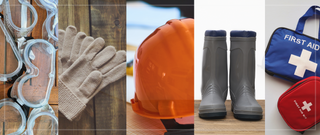A productive and convenient rockhounding trip requires thorough preparation. And by preparation, we mean assembling a complete set of equipment.
After identifying your desired rockhounding spot, you'll want to be armed with the necessary (and your preferred) tools that will help you collect rocks and minerals safely and with ease.
Here's the ultimate checklist of tools and equipment for beginner rockhounds.
What to Bring for a Safe Rockhounding Experience

- Goggles - This is the most basic safety equipment you must bring to every rockhounding trip. You'll need a reliable pair of safety goggles to protect your eyes from dust, chips, and metal fragments.
- Gloves - Wear a pair of work gloves to keep your hands clean and protect from possible cuts and scrapes when hammering through rocks.
- Hard hat - If your trip involves exploring caves, cliffs, and other areas where rock falls are possible, it's always best to wear a hard hat.
- Appropriate footwear - Wear boots with ankle support for treading on mountains with rough terrains, or waterproof boots for walking on lakes, rivers, and tailings.
- First aid kit - For emergency purposes, always have a first aid kit ready for treating minor injuries.
Tools to Bring for Collecting Specimens

- Rock hammer/rock pick - This simple yet essential rockhounding tool is used to pry or chip away at small to medium-sized rocks. Not for use on large rocks.
- Crack hammer - Weighing around 2 to 4 pounds, this smaller version of a sledge hammer is for breaking rocks. It is used together with a chisel. Make sure to bring one you can handle easily.
- Chisel - Depending on your preference, you can bring one or different sizes of chisel, either pointed or wide-bladed. Regardless of the size and shape, use chisels intended for masonry. Wood or metal chisels are not cut out for rockhounding. Chisels with handguards are easier, more comfortable to use, and prevent injuries.
- Pry bar - This tool is for moving large rocks and debris that are too heavy to lift. A pry bar that's 18 to 22 long should be light enough for this purpose.
- Cleaning tools - Need to rid your specimens of soil and grime to identify them easily? Bring a paintbrush, a small broom, and a spray bottle with water to the site.
- Hand tools - A variety of hand tools like a small knife, picks, a colander, and a trowel are useful for precise work.
- Shovel - In case you need to remove dirt, rocks, or grass from the surface to retrieve specimens, bring a full-size shovel to help you do the job.
- Sledgehammer/mason's hammer - This tool is for breaking huge rocks. If you need to bring one, make sure you can swing it comfortably as sledgehammers and mason's hammers can be quite heavy to use.
Tools for Easier Navigation

Normally, your trusty smartphone's GPS is good enough as a navigation tool. But you're going to need an old-school option when you're in the middle of a secluded area where cell or internet service is patchy.
A compass and topographic map will aid you in finding your way to the site and back. Plus, they're affordable and reliable wherever you go.
What to Use for Carrying Specimens and Equipment
Take note of the following items to use to carry and transport your newly found specimens from the site to your home:
- Bucket - A bucket is a good option for containing multiple specimens. You can prepare buckets of different sizes. Get durable ones that can handle heavy loads.
- Small boxes and tubes - These containers come in handy when packing small or delicate specimens. Also prepare different sizes of tubes, boxes, and other containers that can cater to assorted specimens.
- Wrapping material - Avoid cramming hard and fragile specimens together in one container to keep them from getting chipped or broken. Wrap them in newspaper or fabric so they don't jostle with each other during transport.
Tools for Determining Collectible Specimens

It's easier to identify rocks and minerals that are worth collecting when you have the below tools in your rockhounding armory:
- Magnifying glass - This tool helps you examine the qualities of the specimen you're holding. You can also use a loupe for this purpose.
- Local field guide - Consider this as your map which provides you specific information on where to go and what specimens to look for when in the location.
- Magnet - Any kind of magnet is a perfect tool for determining rocks that contain iron such as magnetite and hematite.
- Spray bottle filled with water - It's hard to examine a rock sample when it's covered in dust. Clean it up by spraying water on it and wiping off the dirt with a rag.
What to Bring for a Comfortable Trip

Prepare for your rockhounding adventure like you would for a hike. Since you'll be outdoors and will be exposed to different elements, we recommend the following essentials (dependent on the weather, terrain, and duration of your trip):
- Sun hat/bandana
- Rain gear
- Extra clothes and shoes
- Food and water
- Sun screen
- Hand sanitizer
- Bug spray
- Flashlight
- Whistle
- Camera
- Toilet paper and tissues
- Trash bag
This list looks plenty and you don't have to follow it to a tee. Like what most beginner rockhounds do, you can start with the most important equipment and build from there. What matters is that you have just the right items that will make your trip safe, comfortable, and memorable.
Note: Before hitting the road, research about potential hazards related to the location you'll be visiting so you'd know which specific safety equipment to pack.
Sources:
How to Start Rockhounding: The Ultimate Beginner's Guide. (n.d.). How to Find Rocks. Accessed at https://howtofindrocks.com/how-to-start-rockhounding/#15-finding-specimens
Rhea, M. (n.d.). Rockhounding “ Tools & Equipment You'll Need in the Field. Rockhound Resource. Accessed at https://rockhoundresource.com/rockhounding-tools-equipment-youll-need-in-the-field/
Mineral Collecting. (n.d.). Bancroft Ontario. Accessed at https://www.bancroftontario.com/rock-collecting-sites/
Powell, M. (n.d). PROVIDING FIRST AID IN AN OUTDOOR ENVIRONMENT. First Response Training. Accessed at https://www.firstresponse-ed.com/blog/providing-first-aid-in-an-outdoor-environment/
Taylor, S. (2005). Pleasures and Dangers of Rockhounding Abandoned Mine Areas. Legends of America. Accessed at https://www.legendsofamerica.com/trs-rockhoundingmines/





